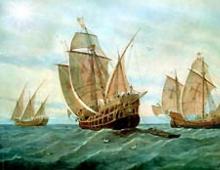Glacier bay national park in alaska. Glacier National Park U.S.A.
With the Canadian provinces of British Columbia and Alberta. Currently, about 37 glaciers remain in the park. Glacier Park is part of a huge ecosystem that has come down to our time almost unchanged. Glacier impresses with its wild meadows, emerald valleys, incredible mountain peaks and amazing waterfalls. On the territory of the reserve there are more than a hundred lakes, thousands of plant species, great amount various wild animals. Glacier is a corner of untouched nature, occupying about 42 thousand square kilometers.
The region that became Glacier Park was originally inhabited by Native American Indians. The Indians predominantly occupied "Blackfeet" to the east and "Flathead" to the west. Under pressure from the federal government, part of the land was vacated in 1895 and later became the territory of the park. In May 1920, shortly after the creation of the park by the Department of the Great Northern railway, several chalets and hotels were built. These buildings are listed as National Historic Landmarks. By 1932 work was completed on the equipment tourist route"Road to the Sun"
This route was one of the first projects designed for auto travelers. This is the only route that passes through the continental divide at Logan Pass at an altitude of 2026 meters. The road was conceived by George Goodwin back in 1917. The construction of the route began in 1921. The entire route was operational at the end of 1933 and cost the Treasury $2.5 million.
The main attractions of the Glacier Park
The largest lake in Glacier is McDonald. The width of the lake is about 16 kilometers, the length is 1.6 kilometers. The depth of the reservoir is about 130 meters. Lake McDonald is located at an altitude of 960 meters on the western side of the American Continental Divide. The surface area of the lake is 27.6 square kilometers. The lake is home to many species of trout, salmon, and sockeye salmon. Grizzly bears, black bears, moose and deer are found near the lake. The lake is surrounded by a dense coniferous forest dominated by various types of spruce, fir and larch. On the shore of the lake you can stop for the night, have a bite to eat, rent a motor boat.
“On the trail of cedars” is the name of the mountain hiking trail. This is 960 meters of equipped route. Walking along it, you can enjoy the mighty cedars, the height of which reaches 24 meters. The trail splits into two parts, one winding while the other continues to Lake Avalanche. On the way among the rocks you will meet an amazing waterfall.
Will especially impress you 170 meter waterfall under the poetic name "Bird Woman". It is clearly visible from a distance of 3 kilometers. The waters of the waterfall are fed by the remains of a glacier located on the northern and western slopes of Mount Oberlin. The waterfall is most full-flowing in late spring and early summer, and in autumn its waters dry up.
"Garden Wall" Alpine meadow, covered in the summer months with dozens of species of flowering plants and shrubs. An unforgettable sight!
national park Glacier is minted on the 25 cent coin in the America the Beautiful series.
How to get there
The park is located in northwestern Montana along the Rocky Mountain range. Glacier Park International Airport (FCA) is the closest to the reserve. It is 30 miles from the western entrance to Glacier National Park and receives flights major airlines from, and other airports in America.
You can also get here by car. The road from Seattle will take about 10 hours, from Canadian Calgary about 6 hours, and from Spokane only 4 hours.
Video: Glacier National Park
Glacier National Park on USA map
(1
ratings, average: 5,00
out of 5)
In order to rate a post, you must be a registered user of the site.
The address: USA, Montana
Foundation date: 1910
Square: 4101 km²
Coordinates: 48°41"06.5"N 113°41"57.7"W
Glacier National Park is a protected corner of nature, spread over an area of more than 4 thousand square meters in the US state of Montana. km, closer to the northern part of the Rocky Mountains. Translated from English, “glacier” (glacier) means “glacier”, but the park received such a name for a reason.
Two Medicine Lake with Mount Sinop in the background
Back in the middle of the 19th century, the local area was surrounded by glaciers - there were more than 150 of them, but due to a change climatic conditions this number has decreased every year. So, today only a fifth of the former number of glaciers has survived, and in the coming decades, due to gradual melting, they may disappear altogether.
Thanks to a number of archaeological discoveries, it has been established that the first settlers occupied the current park area about 10 thousand years ago. The original inhabitants of the area then were Indian tribes: the Blackfoot, Crow, Assiniboine, Cheyenne, Grovantre and Sioux. At the beginning of the 19th century, the expedition of Lewis and Clark began to study the wild glacial area, whose members met here with Indians from different tribes.

Lake Hidden
On the territory of the glacial zone in 1807, Fort Manuel was founded, erected and named in memory of the fur trader Manuel Laysa. Such an outpost appeared in the United States for the first time, and its purpose was to trade with the Indians. But due to the hostility of the representatives of the Blackfoot tribe, trading activities had to be stopped. Other a significant event for the area was the discovery of gold deposits (1858), and the state of Montana was literally overflowing with immigrants. Thus began the "gold rush", due to which Montana turned into the center of the Wild West. Gradually, the deserted territory began to settle down, and soon the first railway crossed the wilderness.
In addition to those suffering to satisfy the "gold rush" and those interested in fur trade, there were also people who were able to truly appreciate the beauty and originality of this natural area. And thanks to the efforts of several enthusiasts, the glacial area in 1910 received the status of National Park, and the name was given to it accordingly - Glacier. Further, work on its improvement was in full swing in the park, and after a while this corner of pristine nature opened up as tourist centre. To date, there are over three hundred buildings for various purposes, which are included in the National Register of Historic Places.

Lake McDonald
You can visit the park area at any time, however, during the autumn-winter period, only limited service will be available to tourists. But from the end of spring to the beginning of warm September, the unique Glacier National Park officially opens its gates for the tourist season.
Whether this enchanting area will exist forever is unknown, because according to scientists' forecasts, the complete disappearance of the remaining glaciers may happen by 2030. Unfortunately, more and more dangerous temperatures are recorded every year, contributing to the melting of glaciers. Be that as it may, the park continues to fascinate visitors with its beauty and it is possible that it will eventually be renamed Glacier Memorial National Park.

MacDonald Falls
Nature of Glacier National Park
Glacier Park is an amazing piece of wildlife that has gathered on its territory many populations of a wide variety of animals. Caribou deer, Canadian lynxes, wolverines, bison, black bears and their relatives grizzlies, wolves, elks, long-horned sheep live here. And mountain deer and goats are so accustomed to people that they walk right under the windows of hotels. The world of birds is also diverse. The bald eagle, blue heron, American swan, falcon, golden eagle and peregrine falcon are the brightest representatives of the protected fauna. It is noteworthy that the local ecosystem has retained its originality over the years.
But not only for the sake of unusual animals and birds, thousands of tourists come to Glacier National Park every year. Many lakes and waterfalls amaze with their purity and picturesqueness. The most popular natural attraction here is McDonald Lake, recognized as the deepest and longest of all park reservoirs.

Mount Chief
All small lakes, of which there are up to 700 names, are hidden in kars - depressions formed by nature itself in the distant Ice Age. Thanks to glacial deposits, some of the local reservoirs have a turquoise color.
As for the two hundred waterfalls that adorn Glacier Park, the surrounding area has long become a favorite spot for tourist groups. Unfortunately, some waterfalls do not survive drought and dry up. Bird Woman is considered the highest waterfall here, and Swiftcarent and McDonald simply fell in love with tourists and gained great popularity among vacationers.
The flora of this charming place is represented by 1130 plant species. In the highlands, a real tundra is spread, the rest of the territory is covered with coniferous forests. Such an unusual combination is explained by low temperature conditions in the Rocky Mountains.

Mount Reynolds
A 2-hour trip along the "Road to the Sun" is very popular among tourists. You can make the 80-kilometer journey in your own car or on tourist bus Red Jammers, eye-catching with its bright red color and canvas roof. The road starts from the lower sections of the park and ends at an altitude of 2,000 m, at the Continental Pass. Thanks to this trip, tourists get the opportunity to view glossy lakes, evergreen dense forests and seasonal waterfalls from above. And if you want to get acquainted with real Indians, visitors to the reserve can visit its southern part, where the Salish live, or go east to the settlement of the Blackfoot tribe, who arrived in the glacial area back in the 18th century and continue to host here today.
Glacier National Park is located in the US state of Montana near the Canadian border. This park is famous for its forests, mountains and glacial lakes. There are more than 700 lakes here. An interesting fact is that only 131 of them have their own names, the rest are nameless. Many lakes are quite decent in size. The beauty of mountains and glacial lakes always makes the heart beat faster. And Glacier Park is no exception.
It should be recalled that this is the region of the Rocky Mountains, and it is extremely rich in amazing reservoirs. For example, to the north of Glacier Park there is Canada's Banff National Park, also famous for its lakes, such as Lake Louise, Moraine Lake and Peyto Lake.
Among such a variety of mountain lakes in the Glacier Park, the most remarkable should be highlighted. This is Lake McDonald. It is the largest here, and is located in the northern part of the park, 40 kilometers south of the border with Canada.
Lake McDonald on the map
- Geographic coordinates 48.591376, -113.914942
- The distance from the capital of the USA Washington is about 3150 km in a straight line
- To the nearest International Airport Spokane about 300 km
Lake McDonald has an elongated shape from the northeast to the southwest. Its length is slightly more than 15 kilometers, and its width reaches 1600 meters. Max Depth 141 meters. The water surface area is 27.6 square kilometers.

The places here are extremely amazing and amazing, but this is not even the main thing. The main difference between some lakes is the multi-colored stones that cover their bottom and coasts. This effect is most colorful in Lake McDonald. Stones of bizarre, sometimes some unreal colors are abundantly scattered around the lake. Reds, yellows, greens and even blues mixed together in a fairy tale.

And if the appearance of multi-colored stones on the famous Glass Beach in California is easily explained by the disgusting unscrupulous attitude of man to nature, then the colored stones of Lake McDonald are entirely the merit of the planet.
Without going into detailed geological analysis, we will only say that the color of pebbles is due to the content of iron in sedimentary rocks and the degree of its oxidation. So, for example, where iron is in close contact with air, red colors predominate. But green colors are characteristic of stones formed at great depths, where oxygen access is very limited.
But who poured this splendor into the lake? Is it possible that the mythical truck was carrying colored stones for the construction of the rainbow, but got lost and unloaded the contents in the wrong place? In fact, everything is simple.
Initially, there were rocks that formed over millions of years and, depending on the conditions, acquired those very amazing colors. Subsequently, during the ice age, these rocks were ground into small pebbles by giant ice blocks. Streams of melt water brought colored stones to the valley, which was filled with glacial runoff.
Colored stones are also found in other lakes of the park, but their number is maximum in Lake McDonald, which looks very impressive.

Another feature of the lake is its indescribable purity, which puts it on a par with such clean water bodies as, for example, the Verzasca River in Switzerland. The purity of the water in Lake McDonald is due to its temperature, which never rises above +10 degrees Celsius. Such conditions do not allow plankton to multiply and survive here, and, accordingly, this is where the transparency of the water comes from. The bottom here can be seen at a depth of 8-10 meters, and sometimes even deeper.
If the plankton is uncomfortable in the lake, then the fish feel like ... "fish in the water." There are quite a lot of fish species here. Especially trout and salmon. Lake McDonald is surrounded by dense coniferous forests dominated by fir, spruce and larch. There are also many animals in the area. Moose, deer and bears are found here.
For tourists around the lake laid 15 hiking trails different lengths and complexity. On the shore of the lake you can find infrastructure for tourists. These are hotels, cafes and canteens, as well as boat rentals.
Lake McDonald photo







